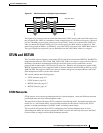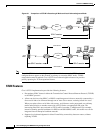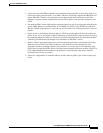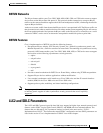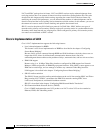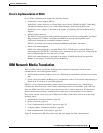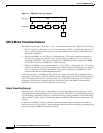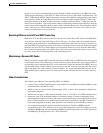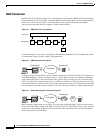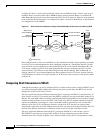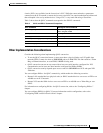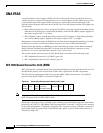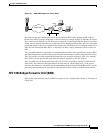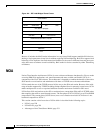
Overview of IBM Networking
IBM Network Media Translation
BC-221
Cisco IOS Bridging and IBM Networking Configuration Guide
As part of its virtual telecommunications access method (VTAM) configuration, the IBM node on the
Token Ring has knowledge of the SDLLC VTRA of the serial device with which it communicates. The
SDLC VTRA and the SDLLC virtual ring number are a part of the SDLLC configuration for the router’s
serial interface. When the Token Ring host sends out explorer packets with the SDLLC VTRA as the
destination address in the MAC headers, the router configured with that SDLLC VTRA intercepts the
frame, fills in the SDLLC virtual ring number address and the bridge number in the RIF, then sends the
response back to the Token Ring host. A route is then established between the Token Ring host and the
router. After the Cisco IOS software performs the appropriate frame conversion, the system uses this
route to forward frames to the serial device.
Resolving Differences in LLC2 and SDLC Frame Size
IBM nodes on Token Ring media normally use frame sizes greater than 1 KB, whereas the IBM nodes
on serial lines normally limit frame sizes to 265 or 521 bytes. To reduce traffic on backbone networks
and provide better performance, Token Ring nodes should send frames that are as large as possible. As
part of the SDLLC configuration on the serial interface, the largest frame size the two media can support
should be selected. The Cisco IOS software can fragment the frames it receives from the Token Ring
device before forwarding them to the SDLC device, but it does not assemble the frames it receives from
the serial device before forwarding them to the Token Ring device.
Maintaining a Dynamic RIF Cache
SDLLC maintains a dynamic RIF cache and caches the entire RIF; that is, the RIF from the source station
to destination station. The cached entry is based on the best path at the time the session begins. SDLLC
uses the RIF cache to maintain the LLC2 session between the router and the host FEP. SDLLC does not
age these RIF entries. Instead, SDLLC places an entry in the RIF cache for a session when the session
begins and flushes the cache when the session terminates. You cannot flush these RIFs because if you
flush the RIF entries randomly, the Cisco IOS software cannot maintain the LLC2 session to the host
FEP.
Other Considerations
The following are additional facts regarding SDLC and SDLLC:
• As part of Cisco’s SDLC implementation, only modulus 8 Normal Response Mode (NRM) sessions
are maintained for the SDLC session.
• SDLC sessions are always locally acknowledged. LLC2 sessions can be optionally configured for
local acknowledgment.
• SDLLC does not apply to SNA subarea networks, such as 37x5 FEP-to-37x5 FEP communication.
• Parameters such as the maximum number of information frames (I-frames) outstanding before
acknowledgment, frequency of polls, and response time to poll frames can be modified per interface.
If local acknowledgment is not enabled, these parameters are modified on the SDLC interface. If
local acknowledgment is enabled, these parameters are modified on the Token Ring interface.
• Local acknowledgment only applies when the remote peer is defined for RSRB using IP
encapsulation over a TCP connection. If no local acknowledgment is used, the remote peer can be
defined for RSRB using direct encapsulation, RSRB using IP encapsulation over an FST connection,
or RSRB using IP encapsulation over a TCP connection.



